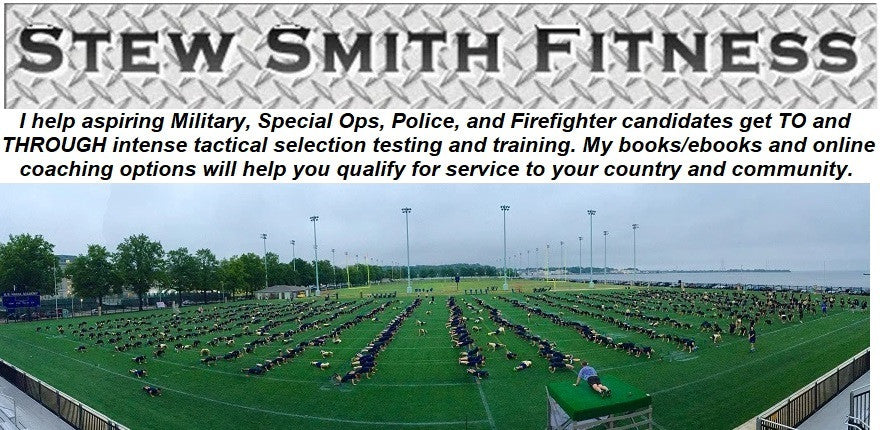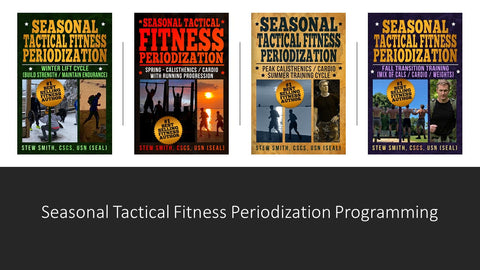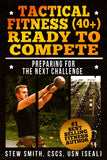Fatigue Resistance - What is it and
How do we Build it?

Stew Smith and Jeff Nichols discuss (TFR 240) what being fatigue resistant is and how to build it. Check out the wide spectrum of ways to build it and how to feed it throughout all the phases of tactical fitness and special ops selection prep.
What is Fatigue Resistance?
Defined by the Google Machine - "Fatigue resistance is the body's ability to resist developing fatigue. It's related to factors that can improve endurance in specific situations, such as stress due to heat, metabolism, and cardiovascular demand. Fatigue resistance is genetically linked to muscle fiber type. People with more slow-twitch fibers tend to experience delayed onset of fatigue, compared to people with more fast-twitch fibers."
Defined by Stew - Training for selections that require long days that turn into the night and require near continuous movement - requires fatigue resistance that is a function of nutrition, hydration, electrolytes, and high volume repetitions, endurance, and strength durability.
Defined by Jeff - It depends on what you are trying to develop - sports or tactical. It is also posture specific - enduring long events with proper posture no matter what the activity or movement. Basically, it is the ability to hold the proper posture and perform with high levels of accuracy for long periods of time with a wide variety of movements through fatigue, heat/cold, and immediate stress.
It Depends...
The process first begins with - IT DEPENDS. It depends on the athletes history of training, strengths, and weaknesses and, of course, goals. An athlete with strength / power focus for years will have a slightly different journey than the endurance based athlete. Check out the video discussion below:
Some of the details in the video discuss the urgency of the one thing that cannot be neglected - FUEL.
#1 – FUEL - Fueling properly is having a solid understanding that the quickest way to fail in a day of long training is to not eat for energy, drink to stay hydrated, and add electrolytes when sweating profusely. Avoiding becoming a heat casualty, cramping, and running out of fuel are the fastest ways to complete your spec ops (or racing) events of the day. Then, understanding you eat/drink to recover from today's events and you also eat/drink to prepare for tomorrow events. Read the article on the topic of nutrition, recovery, longevity and optimal performance.
Also - on the topic of recovery - your sleep is your #1 recovery tool. Do not neglect your sleep as your body needs as much of it as possible when enduring long, difficult days/nights of training. The Mastery of Recovery is the Key to Optimal Performance.

Types of Workouts That Build Fatigue Resistance
These are not a daily activity like fueling and recovery, but a few days of week of mixing in a variety of speed and reps at high intensity, pace of moderate intensity (run, ruck, swim), heavy lifts, light higher rep lifts, shorter rest time or active rest time. Phrases like "rest with running" or "rest with another muscle group" during workouts have a way to increase stamina, speed recovery times when doing nothing and make you more resistant to fatigue. For instance the PT Pyramid with running 400m each set.
#2 – Make Running Harder - There are many ways to increase intensity to help you build a fast recovery system (anti-fatigue). Consider the following:
Hills, soft sand running, stair stepper with weight vest, weighted (rucks, sleds)all are ways to increase the intensity of your running workouts. Check out this workout that incorporates many of the above options into a useful week. - Running Plan to Get To and Through Selection.

#3 – Run/Ruck/Swim THEN PT and Lift - Higher volume lifting, calisthenics, weighted calisthenics for both upper body and lower body mixed with crawls, carries, squats, and lunges can be done either before or after the cardio events. Both work, but my recommendation is to do first what you need to work on the most - then do the other as best you can even though you are fatigued. Part of becoming "fatigue resistant" is to train when fatigued and push through it. You may be able to access a different energy system to propel you through a long workout (or re-fuel / hydrate as needed). See related article - Training Smarter and Harder.
#4 – Keep Moving Workouts - We do a series of workouts throughout the week that pushes our ability to recover with the use of "active rests". We mix in leg PT (squats, lunges, fireman carry, farmerwalks, etc) with running, rucking, or swimming with fins. However, we also mix in upper body PT (pullups, pushups, situps, overhead press, rows, etc) with running and swimming / treading. These types of workouts will help you find different gears of intensity and help guide you to creating useful strategies for actual events you will see again during various tactical training programs.
*Rest as needed when building strength/power/speed. Keep it an active rest when building endurance and muscle stamina.
#5 – Do not forget Cooldown Cardio / Stretch etc - Cooldown run or bike after workouts (lifts / intervals / load bearing etc) then stretching, massage, foam rolling are helpful after long training sessions. Remember fatigue resistance goes much deeper than hard training and recovery - it is a central nervous system developmental process that needs this part of the workout. Cooling down is way more than just lowering body temperature and heart rate. Though it does this too, a cooldown also has central nervous system benefits that help the brain and body disconnect from a "fight or flight" response and move into the "rest and digest" state. See parasympathetic and sympathetic nervous system Stress/Recovery scale as discussed in the video.

#6 – Pushing the Limit Requires Taking DE-LOAD weeks On Occasion – When feeling stressed, tired, or barely getting through workouts take a week to reduce miles, reps, weight by 30-75%. Increase rest, breathing, eat/drink well, and add more gentle movement, flexibility/mobility. Our workouts at StewSmithFitness.com have these built into our Block Periodization programs - every 4th week is a sort of a de-load week where we flip primary and secondary focus events (rest the lifts with cals and cardio and rest the reps/miles with added lifts) See our lessons learned from adding Block Periodization.
#7 – Constantly Pursue RECOVERY. TO keep the see-saw of stress in balance, the big five of recovery need to be fully engaged: sleep, nutrition, hydration, breathing, mobility/flexibility/balance. Fatigue resistance training requires more recovery (food, water, electrolytes, sleep, breathing, relaxing, aka de-stressing the CNS). This has to be not a back-burner item but an ongoing discussion considered throughout each day. The Mastery of Recovery = Optimal Performance but guess what? The Master of Recovery = Longevity as well.

#8 - Eventually the discipline of consistent training will build mental toughness - When you feel like the tank is empty and it will be at some point of your training, finding the fuel when the tank is empty is something else. How bad you want it and your discipline to continue training leads to a mental toughness that will get you though when tired. Read related articles on the process of building mental toughness alongside your fatigue resistance.

Join Stew Smith's LIVE QA on YouTube, where he dissects and critiques submitted CSS videos and takes your questions LIVE! 930am Mondays / Tuesdays at Stew Smith Fitness YouTube Channel.
No Matter What Phase of Preparation You Are In - We Have an Answer For You
(In fact, there are more than 40 books, 1000+ articles, online coaching - and more)

Who is Stew Smith CSCS? Coach, Trainer, Writer, Podcaster: I'm the former Navy SEAL that tactical candidates go to for books, ebooks and online coaching to prepare themselves to get to and through intense tactical assessment and selection programs and qualify for service in their chosen tactical profession. See More at StewSmithFitness.com
Where to Find More Information About Optimal Performance Training Programs
When you start training again, consider the seasonal tactical fitness model. I call it A WAY to train and obviously not the only way to train. But it offers the opportunity to never neglect your weaknesses, helps with flexibility and mobility, but will also put you at a level of physical abilities where you are happy with your overall ability to do just about anything. We have a system where the seasons dictate our training. When it is nicer outside, we tend to run and do more calisthenics. When it is colder and not so nice, we lift more, run less, and still maintain our outdoor activities with shorter runs and rucks. Check it out: Seasonal Tactical Fitness Periodization System.
These Seasonal Tactical Fitness BLOCK Periodization programs will walk you through 4 x 4 weeks cycles with 16 weeks of each season in two programs. (32 total weeks)

Increase Strength & Crush the PST / PAST
3 Weeks Strength - 1 Week PT / Cardio Focus
(16 weeks)
These programs will walk you through 4 cycles with 12 weeks of each season in two programs.
The Specific Military / Special Ops Physical Fitness Workouts

Navy SEAL Workout Phase 1
Navy SEAL Workout Phase 2 - 3
Navy SEAL Workout Phase 4 Grinder PT
Navy SWCC Workout
Army / Air Force Advanced Fitness / Special Ops
Army PFT Workout (Prep For Rucking, OPAT, ACFT)
Army Special Forces / Ranger Workout
Army Air Assault School Workout
Army Airborne Workout
Air Force Special Warfare IFT / OFT / Selection Prep



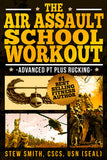
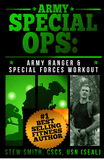


Advanced Running Program - Special Ops Supplement Plan
USMC RECON / MarSOC Workout
USMC OCS / TBS Workout
USMC IST and PFT
The Combat Conditioning Workout
Air Force PJ / CCT Workout Battlefield Airman Prep Course
The UBRR Upper Body Round Robin Workout / Spec Ops version
The Coast Guard Rescue Swimmer / Navy SAR Workout
The Service Academy Workout (West Point, Navy, Air Force Academy)
The Navy, Air Force, Marine Corp Boot Camp Workout
The Law Enforcement Physical Fitness Workouts
The FBI Academy Workout | FBI Workout Vol 2
The DEA Workout
The FLETC Workout - Ace the PEB
The PFT Bible: Pushups, Sit-ups, 1.5 Mile Run
The Fire Fighter Workout - Ace the CPAT
Tactical Fitness Over 40 Series
Tactical Fitness (40+) Phase 1, Phase 2, Phase 3, Phase 4
Online Coaching Options
Online PT CLUB - Weekly Workouts created personally for you.
New Member's Only Content / Services Program!
If you want access to years worth of workouts, many of the top eBOOKs, favorite workouts of the week, free fitness APP, closed Facebook Group, video / picture library of exercises, and more access to LIVE Q/A sessions check out the Stew Smith Fitness Members Section.
The dashboard below has the links to all the information, archives, videos, and links to workouts, podcasts, live Q and A lessons.
Consider this! - A Membership Program and Gain Access to Exclusive Content
(click for Fitness Club Dashboard - members only)
Questions? Just email - Stew@StewSmith.com
At StewSmith.com - List of Products and Services
- FREE Articles.
- Podcasts and Swimming Videos (Youtube, TikTok, Instagram)
- eBooks
- Books and eBooks in PRINT
- Stew Smith Fitness Club membership site
- Online Coaching
Stew Smith Fitness
